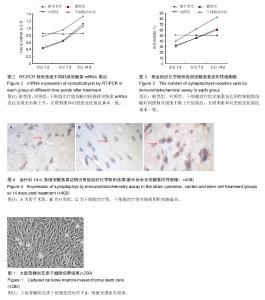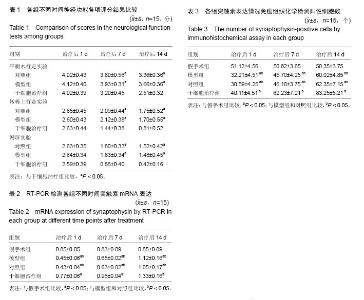| [1] 翁金森,刘楠,杜厚伟,等.骨髓间充质干细胞移植对脑梗塞大鼠神经功能恢复及突触素表达的影响[J].细胞与分子免疫学杂志,2008,24(1):34-37.
[2] 翁金森.骨髓间充质干细胞移植改善脑梗塞大鼠神经功能及其机制的实验研究[D].福建医科大学,2008.
[3] 曹文锋,王卫真,高幼奇,等.立体定向移植骨髓间充质干细胞对脑缺血再灌注模型大鼠的治疗作用[J].中国神经精神疾病杂志,2011,37(7):385-389.
[4] Kim DY,Park SH,Lee SU, et al.Effect of human embryonic stem cell-derived neuronal precursor cell transplantation into the cerebral infarct model of rat with exercise. Neurosci Res. 2007;58(2):164-175.
[5] Rice HE,Hsu EW,Sheng H et al.Superparamagnetic iron oxide labeling and transplantation of adipose-derived stem cells in middle cerebral artery occlusion-injured mice. AJR Am J Roentgenol. 2007; 188(4):1101-1108.
[6] 刘静华.骨髓间充质干细胞静脉移植对脑梗死大鼠治疗作用的研究[D].河北医科大学,2009.
[7] 宋艳玲.VEGF基因修饰的骨髓间充质干细胞移植治疗脑梗塞大鼠的实验研究[D].华中科技大学,2011.
[8] 姜国晶,杨文丽,王鹏等.干细胞移植治疗脑梗塞研究现状[J].实用心脑肺血管病杂志,2008,16(4):307-311.
[9] Ishikane S,Hosoda H,Yamahara K, et al.Allogeneic transplantation of fetal membrane-derived mesenchymal stem cell sheets increases neovascularization and improves cardiac function after myocardial infarction in rats. Transplantation. 2013; 96(8):697-706.
[10] Gutierrez Fernandez M,Rodriguez Frutos B,Alvarez Grech J, et al.Functional recovery after hematic administration of allogenic mesenchymal stem cells in acute ischemic stroke in rats. Neuroscience. 2011; 175:394-405.
[11] 桂莉.大鼠骨髓间充质干细胞的生物学特性及移植治疗脑梗塞的初步研究[D].第三军医大学,2003.
[12] 樊建玲.人骨髓间充质干细胞在大鼠脑内移植的研究[D].浙江大学,2006.
[13] 刘敬霞.脑脉通联合骨髓间充质干细胞移植对脑缺血再灌注大鼠神经细胞再生的影响[D].北京中医药大学,2007.
[14] Nomura T,Honmou O,Harada K,et al.I.V. infusion of brain-derived neurotrophic factor gene-modified human mesenchymal stem cells protects against injury in a cerebral ischemia model in adult rat. Neuroscience. 2005;136(1):161-169.
[15] Suzuki J,Sasaki M,Harada K,et al.Bilateral cortical hyperactivity detected by fMRI associates with improved motor function following intravenous infusion of mesenchymal stem cells in a rat stroke model.Brain Res.2013;1497:15-22.
[16] 薛静,高培毅,李晋,等.脑梗死大鼠脑内移植超顺磁性氧化铁颗粒标记神经干细胞后的MR示踪研究[J].中华放射学杂志,2006,40(2):122-126.
[17] 王杰华.脂肪来源的干细胞移植对脑梗塞大鼠的作用及其机制研究[D].福建医科大学,2009.
[18] 姚晓黎,张成,卢锡林,等.参芪扶正注射液诱导成人间质干细胞治疗脑梗塞的实验研究[J].中国中西医结合杂志, 2005,25(7):629-632.
[19] 沈丽萍.经鼻给予人脐带血间充质干细胞条件培养基改善大鼠脑梗塞后神经功能的研究[D].徐州医学院,2013.
[20] 郑成刚,衣洪杰,刘青乐,等.高压氧动员造血干细胞治疗脑梗塞的作用及机制[C].中华医学会第二十三次全国高压氧医学学术会议, 2014.
[21] Zhang P,Li J,Liu Y,et al.Human embryonic neural stem cell transplantation increases subventricular zone cell proliferation and promotes peri-infarct angiogenesis after focal cerebral ischemia. Neuropathology. 2011; 31(4):384-391.
[22] Sakurai Chin C,Ubara Y,Suwabe T,et al.AL amyloidosis with IgD-lambda monoclonal gammopathy and lambda-type Bence-Jones protein: successful treatment by autologous stem cell transplantation. Clin Exp Nephrol. 2010;14(5):506-510.
[23] 苏柱新.神经干细胞移植治疗脑梗塞后遗症16例临床分析[J].医学信息(下旬刊),2011,24(2):142-143.
[24] Zhang P, Li J, Liu Y et al.Transplanted human embryonic neural stem cells survive, migrate, differentiate and increase endogenous nestin expression in adult rat cortical peri-infarction zone. Neuropathology. 2009;29(4):410-421.
[25] Yin Y,Zhou X,Guan X,et al.In vivo tracking of human adipose-derived stem cells labeled with ferumoxytol in rats with middle cerebral artery occlusion by magnetic resonance imaging. Neural Regen Res. 2015; 10(6): 909-915.
[26] Mouhieddine TH,Kobeissy FH,Itani M,et al.Stem cells in neuroinjury and neurodegenerative disorders: challenges and future neurotherapeutic prospects. Neural Regen Res. 2014;9(9): 901-906。
[27] 黄敬.细胞移植及药物治疗血管性痴呆的实验研究[D].华中科技大学,2006.
[28] 宋彧琳.突触素在大鼠局灶性脑缺血再灌注损伤和慢性糖尿病大鼠局灶性脑缺血再灌注损伤的表达和意义[D].大连医科大学,2005.
[29] 石学魁,沈小平,王婷,等.中药活脑康对大鼠脑缺血损伤后TGF-β1与P38的表达的影响[C].//中国青年科学家论坛暨第四届全国中医药免疫学术研讨会论文集.2007: 31-34.
[30] Ruan GP, Han YB, WangTH. et al.Comparative study among three different methods of bone marrow mesenchymal stem cell transplantation following cerebral infarction in rats. Neurol Res. 2013; 35(2): 212-220.
[31] Liu YP, Seckin H, Izci Y, et al. Neuroprotective effects of mesenchymal stem cells derived from human embryonic stem cells in transient focal cerebral ischemia in rats. J Cereb Blood Flow Metab. 2009; 29(4):780-791.
[32] 胡炜,杨枫,唐尤佳,等.羊膜脱细胞基质对脐血间质干细胞突触蛋白表达的影响[J].中国组织工程研究与临床康复, 2011,15(14):2500-2503.
[33] Moon HH, Joo MK, Mok H, et al.MSC-based VEGF gene therapy in rat myocardial infarction model using facial amphipathic bile acid-conjugated polyethyleneimine. Biomaterials.2014;35(5):1744- 1754.
[34] Lu W,Li Z,Tian Z. et al.Clinical transplantation of human embryonic neural stem cells for the treatment of cerebral infarction sequelae.Neurosurgery quarterly. 2013,23(1):58-60.
[35] 王彦永,娄淑杰,顾平,等.中脑神经干细胞分化的神经元体外表达突触素的动态分析[J].解剖学杂志,2005, 28(3): 255-257,272.
[36] 杨春,周辉,白琳琳,等.神经干细胞移植对阿尔茨海默病大鼠海马突触素表达和学习记忆能力的影响[J].中国组织工程研究与临床康复,2010,14(10):1803-1807.
[37] Wang J, Chao F, Han F, et al. PET demonstrates functional recovery after transplantation of induced pluripotent stem cells in a rat model of cerebral ischemic injury. J Nucl Med. 2013;54(5):785-792.
[38] Nakano Doi A, Nakagomi T, Fujikawa M, et al.Bone marrow mononuclear cells promote proliferation of endogenous neural stem cells through vascular niches after cerebral infarction.Stem Cells,2010; 28(7):1292- 1302.
[39] Jiang Y, Zhu W, Zhu J, et al. Feasibility of delivering mesenchymal stem cells via catheter to the proximal end of the lesion artery in patients with stroke in the territory of the middle cerebral artery. Cell Transplant. 2013;22(12):2291-2298.
[40] 马海英,喻博,孔力,等.大鼠脑皮质神经干细胞定向分化为神经元过程中突触素的表达[C].中国解剖学会2010年年会,2010.
[41] 马海英,喻博,关水等.在大鼠创伤性脑损伤模型中神经干细胞移植对突触素表达的影响[J].中国组织化学与细胞化学杂志,2011,20(6):627-633.
[42] 齐志国,朱晓峰,富奇志等.神经干细胞与血管内皮祖细胞共移植促进移入缺血再灌注模型大鼠脑内神经干细胞向神经元分化和突触的形成[J].第三军医大学学报,2010, 32(7):625-629. |



